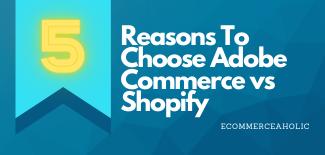I get it, you guys aren’t eCommerce platform experts and you shouldn’t be. It’s your job to be an expert in whatever your business does. Choosing an eCommerce platform is a big decision. You’re going to invest your hard earned money to build your business on this thing and this decision is going to define your business online for the next several years. That’s a lot of pressure.
Well, I am going to try and simplify it for you. In this video, I’m going to give you 5 reasons to choose Adobe Commerce (formerly Magento) over Shopify.
Choosing an eCommerce platform can be a subtle, nuanced process. It often comes down to the smallest difference or feature that makes one direction better than another. There’s no way we can go through everything in a single video. This video is not a feature comparison. It’s more of 5 big things that you can look for that, if they apply to your business, can make your decision a lot easier. With that in mind, it really applies to Shopify, Shopify Plus, Adobe Commerce (formerly Magento) Open Source, or Adobe Commerce (formerly Magento) Commerce.
This particular video outlines 5 reasons Adobe Commerce (formerly Magento) might be better for you than Shopify but this is one in a series of platform comparisons. I’m going to give you 5 reasons to choose Shopify as well and I’ll link you to that video at the end of this one.
No one is unbiased. I have my favorite platforms. We are Adobe Commerce (formerly Magento) partners but don’t do so much with Shopify. However, I’m not going to steer you wrong, either.
- Controversial or high risk industries:
If you are in an industry where laws or public sentiment is constantly evolving, the open source nature and flexibility of Adobe Commerce (formerly Magento) is going to give you stability that you can never have on Shopify. Shopify has a history of allowing businesses to invest and build on their platform only to change their mind and give them weeks to find and migrate to another optionYou don’t want that kind of worry and risk. You need to be thinking long-term, and that risk is a constant distraction and is not healthy for your business. if you are in a controversial or high risk industry like firearms or vape products then the flexibility that Adobe Commerce (formerly Magento) provides like being able to move to a different host or select a new payment provider means that someone can’t just tell you “no”. Basically, you have options and there’s not just one provider that can completely shut you down. - Control:
Sometimes you really need control.. and other times you really just want control. If you are in heavily regulated industries like pharmaceuticals it may be absolutely necessary for you to have full control over your hosting stack. Perhaps there are certain technologies you want to use like AWS or Azure or you have your own system administrators and want more access to your hosting. That makes Adobe Commerce (formerly Magento) a no-brainer vs Shopify.I also often talk to merchants that just don’t like or trust SaaS platforms. Just don’t care for the business model at all. Regardless of any benefits, not a fan. If you are one of these people, then I’m not sure why you are watching this video. You’ve already made your decision. But, I appreciate your support so thanks for watching, I guess. - B2B eCommerce
B2B eCommerce is a whole different animal than B2C. Negotiated pricing, quotes, corporate accounts are all things that are the bare minimum to meet customer demands. The flexibility of Adobe Commerce (formerly Magento) also allows you to craft custom user experiences specific to your industry and products if you really want to do B2B right.Adobe Commerce (formerly Magento) also has the flexibility needed to handle the most complex data needs. You can tie into whatever poorly thought out and archaic back office systems you may have cobbled together over the last 50 years. - Flexibility and scalability:
Most eCommerce platforms are designed to provide middle of the road functionality that appeals to a large collection of merchants. In some cases, that may not provide everything you need to execute on your eCommerce vision. If you are going to step outside of the norm and build something extremely custom, then you have more options with the flexibility that comes with the open source nature of the Adobe Commerce (formerly Magento) platform.As far as scalability, you can build an empire on the Adobe Commerce (formerly Magento) platform.What I’m talking about is the complexity of scale and providing a unified eCommerce experience across that business. Do you have a chain of physical stores and need to integrate your website’s order management and inventory across those locations? As in, your customer can see the inventory in their local store, order it, and then pick it up this afternoon? Adobe Commerce (formerly Magento) can do that.Do you have 5 or 10 international brands that all need eCommerce experiences that are optimized for multiple languages and fully integrated with your back office systems? Adobe Commerce (formerly Magento) can do that.. on one installation.If your goals are world domination or your business has a lot of complexity, then Adobe Commerce (formerly Magento) is an obvious choice. - Innovating:
If you want to be ahead of the curve of technology or user experiences, then you are going to need the flexibility that an open source platform provides. A big example right now are progressive web apps and headless eCommerce. There are ways to build a PWA on Shopify. However, unless your needs are basic you’ll eventually run into some feature that needs to be customized or custom built. Depending on what it is, if you are on a SaaS platform like Shopify then you may not have the ability to do that customization. So, if your desire is to be an innovator, then open source is going to be better for you than SaaS, so Adobe Commerce (formerly Magento) is going to win over Shopify.
There are a ton of features that you really need to consider to ultimately decide which platform is best for you. However, hopefully these 5 things, if they apply to you make that call a bit easier.
What about an open source option? Read our guide to SaaS vs Open Source eCommerce platforms if you want to explore this option.
If you want to see the counter argument on why you should choose Shopify, try this article: 5 reasons to choose Shopify vs Adobe Commerce (formerly Magento)





